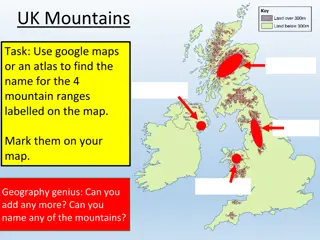Understanding Rock Ages: A Geologic Perspective
Geologists determine the ages of rocks and the Earth using principles like Uniformitarianism, Relative Age, Law of Superposition, and Principle of Original Horizontality. By analyzing rock layers, sedimentary structures, and unconformities, they estimate Earth's age to be around 4.6 billion years old, challenging older beliefs of a much younger Earth.
Download Presentation

Please find below an Image/Link to download the presentation.
The content on the website is provided AS IS for your information and personal use only. It may not be sold, licensed, or shared on other websites without obtaining consent from the author. Download presentation by click this link. If you encounter any issues during the download, it is possible that the publisher has removed the file from their server.
E N D
Presentation Transcript
CHAPTER 8-THE ROCK RECORD GRAND CANYON VIDEO How can we determine ages of rocks and the Earth?
Section 1: Determining Relative Age Uniformitarianism: a principle that geologic processes that occurred in the past can be explained by current geologic processes-presented by James Hutton in the 18thcentury
Earths Age Geologists estimate that the Earth is about 4.6 billion years old Hutton s work forced geologists to revise the estimated age-it was once believed to be only about 6,000 years old.
Relative Age Rocks form in layers (strata-see example on next slide) Indicates age of rock relative to other layers of rock
Strata-means layers ex) dessert strata
Law of Superposition Undeformed rock layers of sedimentary rock-older layers on bottom
Principle of Original Horizontality Sedimentary rocks left undisturbed will remain in horizontal layers
Other clues about age, see pg. 204 in text Graded bedding-sediments settle according to particle size-if large particles are on top, the layers have been disturbed Cross beds-slanted layers can be used to determine the original position of layers Ripple marks-formed by wind or water and preserved in rock. Ripples point upwards and indicate original position of rock (see pic next slide)
Unconformities, see pg. 205 A break in the geologic record due to movement in the earth s layers. Types: Nonconformity Angular unconformity Disconformity
Crosscutting Relationships A fault or a body of rock that cuts through another rock layer is younger than that layer (it formed after the layer it cuts through) Relative Age Video Clip
Relative Age of Students in Class Without talking, arrange yourselves in age order from the youngest to the oldest (along the back of classroom)
Absolute Age (TB pgs. 207-212) Numeric age of rock or organic matter Methods: Rates of Erosion- use average rate of erosion to find age Rates of Deposition- use average rate of deposition to find age Varve Counts- sediment forms in layers annually-can be counted-similar to tree rings Radiometric Dating- compares amounts of parent and daughter isotopes to determine age of rock using half life Carbon Dating-used for organisms (fossils)-less than 70,000 years old, cannot be used on rock
Radiometric Dating Used to find absolute age by comparing amount of parent to daughter isotope-find out how many lives have passed. Half life-time it takes for of a radioactive sample to decay from parent to daughter isotope.
Carbon Dating Watch the Brain POP: Carbon Dating: -what are the limitations of using carbon dating?























